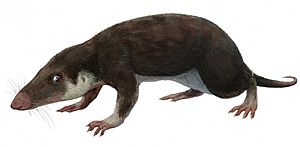Morganucodon facts for kids
Quick facts for kids MorganucodonTemporal range: latest Upper Triassic / earliest Lower Jurassic
|
|
|---|---|
 |
|
| A bronze statue of Morganucodon | |
| Scientific classification | |
| Kingdom: | |
| Subphylum: | |
| Class: | |
| (unranked): | |
| Order: |
Morganucodonta
|
| Family: |
Morganucodontidae
|
| Genus: |
Morganucodon
Kühne, 1949
|
Morganucodon was a very early animal that looked a bit like a mammal. It lived a long, long time ago, around 205 million years ago, during the late Triassic and early Jurassic times.
We know a lot about Morganucodon because many of its fossils have been found. Most of these amazing fossils come from Glamorgan in Wales. Scientists aren't sure if the rocks where they found these fossils are from the very end of the Triassic or the very beginning of the Jurassic period.
Morganucodon was a small creature. Its skull was only about 2-3 centimeters (about 1 inch) long, and its whole body was about 10 centimeters (4 inches) long. It probably looked a lot like a shrew or a mouse that you might see today.
Contents
Where Did Morganucodon Live?
Fossils of Morganucodon have been found in many places around the world. Besides Wales, they have been discovered in the Yunnan Province in China. Scientists have also found them in different parts of Europe and North America.
Some similar animals, like Megazostrodon, have also been found as amazing fossils in South Africa. This shows that these early mammal-like creatures lived across many continents.
What Was Morganucodon Like?
What Did It Eat?
Based on its small size and the shape of its teeth, scientists believe that Morganucodon probably ate insects. This means it was an insectivore.
Keeping Warm and Active
Because Morganucodon was so small, it likely had a way to control its body temperature. This suggests it might have had fur to keep it warm, just like modern mammals.
Being active at night, or nocturnal, would have been a good idea for a small animal like this. To stay active in the dark, it would have needed to produce its own body heat.
How Big Was Its Brain?
Early mammals, including Morganucodon, had bigger brains compared to their body size than their ancestors. Scientists have studied the fossils to figure out how big their brains were.
The brain size of these ancient mammals was similar to the smaller brains of some living mammals today. This was a big jump in brain size compared to even older animals. It probably meant that a special part of the brain, called the neocortex, was starting to develop. This part of the brain is very important for thinking and is a key feature of mammals.
Was Morganucodon a True Mammal?
Scientists have debated for a long time whether Morganucodon should be called a "mammal." Some prefer to put it in a wider group called Mammaliaforms. This group includes mammals and their very close relatives.
Morganucodon is considered very basal or "primitive." This means it has some features that are older and less developed than those in modern mammals. For example, its lower jaw still had some small bones that were found in its reptile-like ancestors. Modern mammals have a lower jaw made of just one bone.
Interestingly, Morganucodon had two ways its jaw could connect! It still had the older, more primitive jaw joint that its ancestors had. But it also had started to develop the newer, more advanced jaw joint that modern mammals have. This makes Morganucodon very special because it shows a step in evolution. In modern mammals, those older jaw bones actually moved into the middle ear and became part of the ear bones, which help us hear!
Another mammal-like feature of Morganucodon was how its teeth grew. Like mammals, it probably grew only two sets of teeth in its lifetime. Older animals, like reptiles, grow new teeth throughout their lives. This change in tooth growth is another sign that Morganucodon was moving towards being a true mammal.
Images for kids
See also
 In Spanish: Morganucodon para niños
In Spanish: Morganucodon para niños





